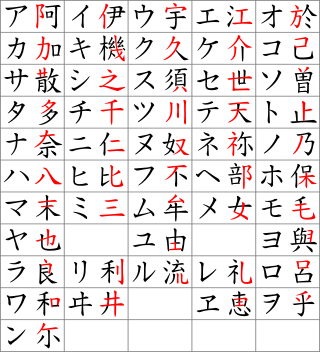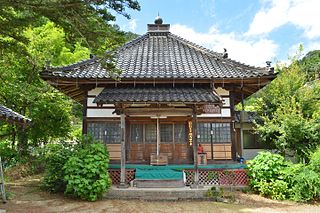The Man'yōshū is the oldest extant collection of Japanese waka, compiled sometime after AD 759 during the Nara period. The anthology is one of the most revered of Japan's poetic compilations. The compiler, or the last in a series of compilers, is today widely believed to be Ōtomo no Yakamochi, although numerous other theories have been proposed. The chronologically last datable poem in the collection is from AD 759 (No. 4516). It contains many poems from a much earlier period, with the bulk of the collection representing the period between AD 600 and 759. The precise significance of the title is not known with certainty.

The Nara period of the history of Japan covers the years from 710 to 794. Empress Genmei established the capital of Heijō-kyō. Except for a five-year period (740–745), when the capital was briefly moved again, it remained the capital of Japanese civilization until Emperor Kanmu established a new capital, Nagaoka-kyō, in 784, before moving to Heian-kyō, modern Kyoto, a decade later in 794.

The Yayoi period started in the late Neolithic period in Japan, continued through the Bronze Age, and towards its end crossed into the Iron Age.

Tōdai-ji is a Buddhist temple complex that was once one of the powerful Seven Great Temples, located in the city of Nara, Japan. Though it was originally founded in the year 738 CE, Tōdai-ji was not opened until the year 752 CE. The temple has undergone several reconstructions since then, with the most significant reconstruction taking place in 1709. Its Great Buddha Hall houses the world's largest bronze statue of the Buddha Vairocana, known in Japanese as Daibutsu (大仏). The temple also serves as the Japanese headquarters of the Kegon school of Buddhism. The temple is a listed UNESCO World Heritage Site as one of the "Historic Monuments of Ancient Nara", together with seven other sites including temples, shrines and places in the city of Nara.

Japonic or Japanese–Ryukyuan, sometimes also Japanic, is a language family comprising Japanese, spoken in the main islands of Japan, and the Ryukyuan languages, spoken in the Ryukyu Islands. The family is universally accepted by linguists, and significant progress has been made in reconstructing the proto-language, Proto-Japonic. The reconstruction implies a split between all dialects of Japanese and all Ryukyuan varieties, probably before the 7th century. The Hachijō language, spoken on the Izu Islands, is also included, but its position within the family is unclear.

Man'yōgana is an ancient writing system that uses Chinese characters to represent the Japanese language. It was the first known kana system to be developed as a means to represent the Japanese language phonetically. The date of the earliest usage of this type of kana is not clear, but it was in use since at least the mid-7th century. The name "man'yōgana" derives from the Man'yōshū, a Japanese poetry anthology from the Nara period written with man'yōgana.

Old Japanese is the oldest attested stage of the Japanese language, recorded in documents from the Nara period. It became Early Middle Japanese in the succeeding Heian period, but the precise delimitation of the stages is controversial. Old Japanese was an early member of the Japonic language family. No genetic links to other language families have been proven.

The Shōsō-in (正倉院) is the treasure house of Tōdai-ji Temple in Nara, Japan. The building is in the azekura (log-cabin) style with a raised floor. It lies to the northwest of the Great Buddha Hall. The Shōsō-in houses artifacts connected to Emperor Shōmu (聖武天皇)(701–756) and Empress Kōmyō (光明皇后)(701–760), as well as arts and crafts of the Tempyō (天平) era of Japanese history.
Sino-Xenic or Sinoxenic pronunciations are regular systems for reading Chinese characters in Japan and Korea, originating in medieval times and the source of large-scale borrowings of Chinese words into the Japanese, and Korean ] languages, none of which are genetically related to Chinese. The resulting Sino-Japanese and Sino-Korean vocabularies now make up a large part of the lexicons of these languages. The pronunciation systems are used alongside modern varieties of Chinese in historical Chinese phonology, particularly the reconstruction of the sounds of Middle Chinese. Some other languages, such as Hmong–Mien and Kra–Dai languages, also contain large numbers of Chinese loanwords but without the systematic correspondences that characterize Sino-Xenic vocabularies.

The Kitora Tomb is an ancient tumulus located in the village of Asuka, Nara Prefecture, Japan. The tomb is believed to have been constructed some time between the 7th and early 8th centuries, but was only discovered in 1983.

Fujiwara-kyō (藤原京) was the Imperial capital of Japan for sixteen years, between 694 and 710. It was located in Yamato Province, having been moved from nearby Asuka. However, the name itself was never used in the Nihon Shoki; during those times it was recorded as Aramashi-kyō (新益京).

Nara is the capital city of Nara Prefecture, Japan. As of 2022, Nara has an estimated population of 367,353 according to World Population Review, making it the largest city in Nara Prefecture and sixth-largest in the Kansai region of Honshu. Nara is a core city located in the northern part of Nara Prefecture bordering the Kyoto Prefecture.
Iranians in Japan are a minority group, with official statistics recording about 5,000 Iranian migrants in the country. Part of the Iranian diaspora, most live in the Greater Tokyo Area.

The language of the kingdom of Baekje, one of the Three Kingdoms of Korea, is poorly attested, and scholars differ on whether one or two languages were used. However, at least some of the material appears to be variety of Old Korean.
Proto-Japonic, Proto-Japanese, or Proto-Japanese–Ryukyuan is the reconstructed language ancestral to the Japonic language family. It has been reconstructed by using a combination of internal reconstruction from Old Japanese and by applying the comparative method to Old Japanese and Ryukyuan languages. The major reconstructions of the 20th century were produced by Samuel Elmo Martin and Shirō Hattori.

Bamboo and wooden slips are long, narrow strips of wood or bamboo, each typically holding a single column of several dozen brush-written characters. They were the main media for writing documents in China before the widespread introduction of paper during the first two centuries AD.

Hōryū-ji is a Buddhist temple that was once one of the powerful Seven Great Temples, in Ikaruga, Nara Prefecture, Japan. Its full name is Hōryū Gakumonji (法隆学問寺), or Learning Temple of the Flourishing Law, the complex serving as both a seminary and monastery.

Tajima Kokubun-ji (但馬国分寺) is a Jōdo-shū Buddhist temple located in the Hidaka-chō neighborhood of the city of Toyooka, Hyōgo, Japan. Its main image is a statue of Yakushi Nyorai. It is the modern successor of one of the provincial temples established by Emperor Shōmu during the Nara period (710–794) for the purpose of promoting Buddhism as the national religion of Japan and standardising control of Yamato rule over the provinces. The foundation stones for the original temple were designated as a National Historic Site in 1990, with the area under protection extended in 2000, 2004, 2011, 2013 and 2015.
The Shimookada Kanga ruins is an archaeological site with the ruins of a Nara to Heian period government administrative complex, located in what is now the town of Fūchu in Hiroshima prefecture in the San'yō region of Japan. The site has been protected as a National Historic Site from 2018.













